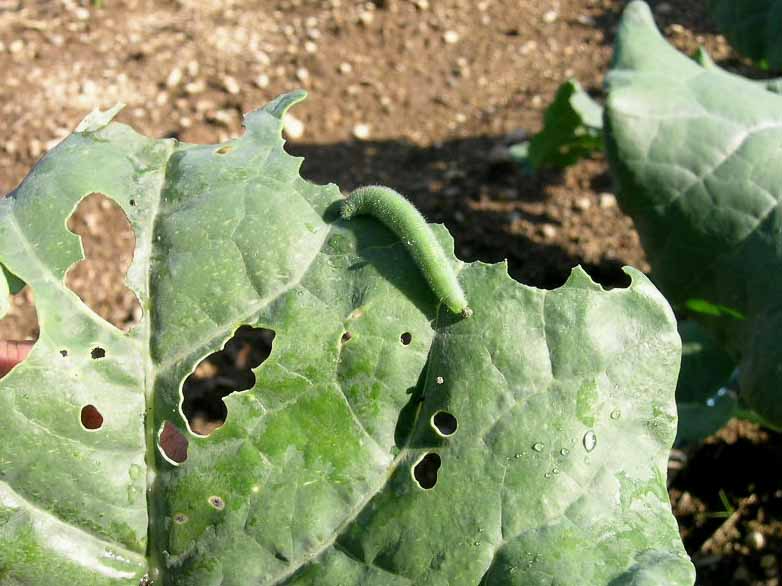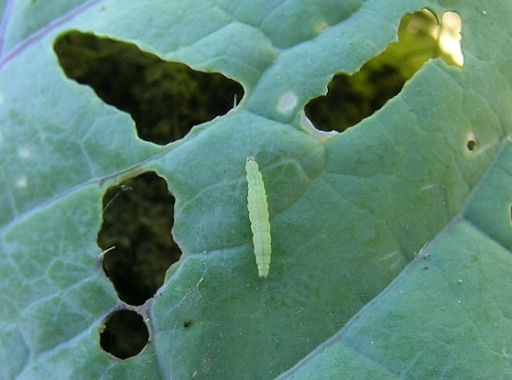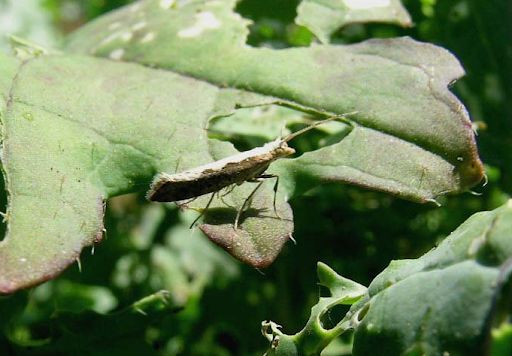
Pests: Imported Cabbageworm (Pieris rapae), Diamondback Moth (Platella zylostella), Cabbage Looper (Trichoplusia ni)
The first sign of imported cabbageworm is typically one or more white moths with dark marks on their wings fluttering around brassica plants during the day. Also known as cabbage whites, these moths lay ⅛-inch long eggs singly on brassica crop leaves, which hatch into a gray-green, somewhat fuzzy and slow moving caterpillar, often growing over an inch long. This is the stage where the cabbageworm causes its feeding damage — the second most obvious sign of their presence, holes chewed through leaves. Caterpillars can often be found resting on the leaf midrib or along other leaf veins. Imported cabbageworm pupate in a distinctive green-to-brown chrysalis, with pointed ridges on its back, often attached to the same plant they fed upon.
Diamondback moth are much harder to notice, until feeding damage has occurred. Adult moths are smaller (half an inch long or so), and make short quick flights when disturbed, unlike the relaxed flutter of cabbage whites (imported cabbageworm adults). Diamondback moth adults are also harder to spot at rest because they fold their wings together. Diamondback moth caterpillars can reach about ¾ inch in length and have a more distinctly segmented appearance than imported cabbageworm. When disturbed, diamondback moth caterpillars can be quite active and will often drop down from the plant, suspended by a length of silk. Feeding damage is often smaller holes than those created by imported cabbageworm, and the feeding is often limited to the underside of the leaf, leaving a transparent “windowpane” from the upper leaf surface.
Cabbage looper often do not show up until mid- to late-season, and sometimes not at all. The adult moth is not very distinctive to the casual observer (“looks like a brown-grey moth”), and they are typically active beginning at dusk or occasionally on cool cloudy days. The most distinctive characteristic of the cabbage looper caterpillar is its “looping” mode of walking, arching its back with each “step” the way an inchworm moves.
All three pests produce multiple generations each growing season, and their entire lifecycles, from egg to adult, can be completed on one brassica host plant. Imported cabbageworm overwinter as pupae in crop debris and are a common pest every year. Diamondback moth probably overwinter as adults in crop debris, though survival in our region is questionable and is more likely to occur in southern New England. The cabbage looper does not overwinter in the north. Diamondback moth and cabbage looper are usually carried up here by storms, therefore problems from these pests vary from year to year and are usually less common than the imported cabbageworm.
Management options:
Cultural:
The most effective control of these pests is to exclude the adult moths from laying eggs on the crop. Row covers work well for this, though can create excessively hot growing conditions for brassica crops in warmer weather. Protek Net and ExcludeNet are brands of exclusion netting that are becoming more popular to exclude insect pests while allowing greater airflow to reduce heat buildup. It is much better to spot these pests early, so scout often. Even if you cannot see the eggs, it is much easier to manage them when they are still tiny caterpillars. Because all three pests produce multiple generations each growing season, it is important to destroy crop debris promptly after harvest, to minimize harboring future generations that will move onto your later plantings.
Biocontrol:
Controlling brassica weeds will help. Natural enemies include birds, native and introduced parasitic wasps, and predatory yellowjacket wasps like the baldfaced hornet.
Pesticides approved for use in certified organic production (as a last resort):
Bt gives good control of all three caterpillars, if applied while they’re still young enough to be feeding, however the “aizawai” strain of Bt is reportedly more effective against diamondback moth than the “kurstaki strain” of Bt. For commercial growers, Dipel is a common kurstaki strain brand, and Agree is an available aizawai strain brand. Bt must be eaten to work and since it degrades quickly in sunlight it should be sprayed when the pest is actively feeding. There is no protective activity. Spinosad works even better than Bt, especially when caterpillars are beyond feeding stages as it is a contact insecticide. Spinosad is more expensive and less selective in what insects it will kill, however. Entrust is the most common brand of spinosad for commercial growers, while Monterey Garden Insect Spray is an example of a few brands labeled for home gardeners. Be sure to scout the crops and spray only when the pest is present, and to follow all label instructions. As usual, if you are a certified grower be sure that the formulation you use is approved for organic production.
Please note: This information is for educational purposes. Any reference to commercial products, trade or brand names is for information only, and no endorsement or approval is intended. Pesticide registration status, approval for use in organic production and other aspects of labeling may change after the date of this writing. It is always best practice to check on a pesticide’s registration status with your state’s board of pesticide control, and for certified organic commercial producers to update their certification specialist if they are planning to use a material that is not already listed on their organic system plan. The use of any pesticide material, even those approved for use in organic production, carries risk — be sure to read and follow all label instructions. The label is the law. Pesticides labeled for home garden use are often not allowed for use in commercial production unless stated as such on the label.
Source material attribution:Informed by: Eric Sideman



